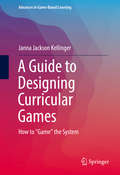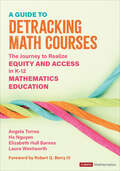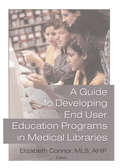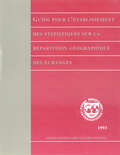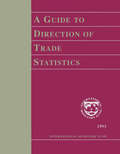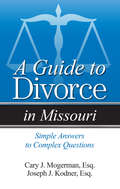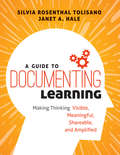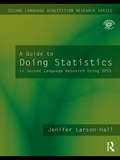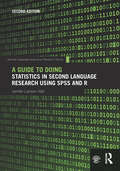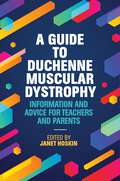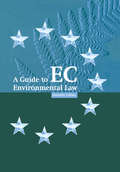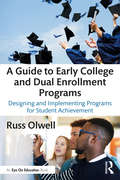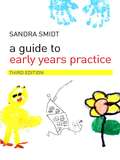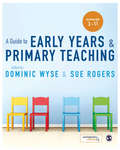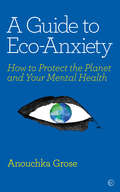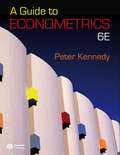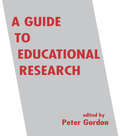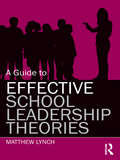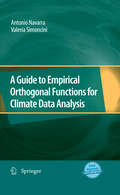- Table View
- List View
A Guide to Designing Curricular Games: How to "Game" the System (Advances in Game-Based Learning)
by Janna Jackson KellingerThis book is a guide to designing curricular games to suit the needs of students. It makes connections between video games and time-tested pedagogical techniques such as discovery learning and feedback to improve student engagement and learning. It also examines the social nature of gaming such as techniques for driver/navigator partners, small groups, and whole class structures to help make thinking visible; it expands the traditional design process teachers engage in by encouraging use of video game design techniques such as playtesting. The author emphasizes designing curricular games for problem-solving and warns against designing games that are simply "Alex Trebek (host of Jeopardy) wearing a mask". By drawing on multiple fields such as systems thinking, design theory, assessment, and curriculum design, this book relies on theory to generate techniques for practice.
A Guide to Detracking Math Courses: The Journey to Realize Equity and Access in K-12 Mathematics Education (Corwin Mathematics Series)
by Angela Nicole Torres Ho Hai Nguyen Elizabeth Crawford Hull Barnes Laura Wentworth StreeterCreate a pathway to equity by detracking mathematics The tracked mathematics system has been operating in US schools for decades. However, research demonstrates negative effects on subgroups of students by keeping them in a single math track, thereby denying them access to rigorous coursework needed for college and career readiness. The journey to change this involves confronting some long-standing beliefs and structures in education. When supported with the right structures, instructional shifts, coalition building, and educator training and support, the detracking of mathematics courses can be a primary pathway to equity. The ultimate goal is to increase more students’ access to and achievement in higher levels of mathematics learning–especially for students who are historically marginalized. Based on the stories and lessons learned from the San Francisco Unified School District educators who have talked the talk and walked the walk, this book provides a model for all those involved in taking on detracking efforts from policymakers and school administrators, to math coaches and teachers. By sharing stories of real-world examples, lessons learned, and prompts to provoke discussion about your own context, the book walks you through: Designing and gaining support for a policy of detracked math courses Implementing the policy through practical shifts in scheduling, curriculum, professional development, and coaching Supporting and improving the policy through continuous research, monitoring, and maintenance. This book offers the big ideas that help you in your own unique journey to advance equity in your school or district’s mathematics education and also provides practical information to help students in a detracked system thrive.
A Guide to Detracking Math Courses: The Journey to Realize Equity and Access in K-12 Mathematics Education (Corwin Mathematics Series)
by Angela Nicole Torres Ho Hai Nguyen Elizabeth Crawford Hull Barnes Laura Wentworth StreeterCreate a pathway to equity by detracking mathematics The tracked mathematics system has been operating in US schools for decades. However, research demonstrates negative effects on subgroups of students by keeping them in a single math track, thereby denying them access to rigorous coursework needed for college and career readiness. The journey to change this involves confronting some long-standing beliefs and structures in education. When supported with the right structures, instructional shifts, coalition building, and educator training and support, the detracking of mathematics courses can be a primary pathway to equity. The ultimate goal is to increase more students’ access to and achievement in higher levels of mathematics learning–especially for students who are historically marginalized. Based on the stories and lessons learned from the San Francisco Unified School District educators who have talked the talk and walked the walk, this book provides a model for all those involved in taking on detracking efforts from policymakers and school administrators, to math coaches and teachers. By sharing stories of real-world examples, lessons learned, and prompts to provoke discussion about your own context, the book walks you through: Designing and gaining support for a policy of detracked math courses Implementing the policy through practical shifts in scheduling, curriculum, professional development, and coaching Supporting and improving the policy through continuous research, monitoring, and maintenance. This book offers the big ideas that help you in your own unique journey to advance equity in your school or district’s mathematics education and also provides practical information to help students in a detracked system thrive.
A Guide to Developing End User Education Programs in Medical Libraries
by Elizabeth ConnorExplore a wealth of ideas, insights, and approaches that can be used or adapted by any medical library!Curricular changes in the health professions, coupled with a growing acceptance of the Internet as a tool for daily living, have contributed to a climate of change and opportunity for health sciences libraries. A Guide to Developing End User Education Programs in Medical Libraries will help graduate students in library science, entry-level medical librarians, and experienced educators to understand best practices and to build, expand, and improve medical library-sponsored educational programs. A Guide to Developing End User Education Programs in Medical Libraries is designed to aid and inform professionals who develop, teach, or evaluate end-user education programs in health sciences libraries. Eighteen case studies represent the ideas and approaches of more than fifteen private and public institutions in the United States and the Caribbean. The studies focus on effective end-user programs for medical information electives, veterinary medicine programs, health care informatics, and evidence-based medicine, plus instructional programs for teaching residents, ThinkPad-facilitated instruction, and more. The guide also examines how several medical libraries have created and expanded their end-user education programs.The contributors to A Guide to Developing End User Education Programs in Medical Libraries are health sciences librarians from teaching hospitals, medical/dental/veterinary schools, and health professions-focused universities in a dozen U.S. states and the West Indies. Each of them is involved in designing, teaching, and evaluating user education. This book will help you educate students of medicine, pharmacy, physical therapy, dentistry, and veterinary medicine, plus residents and practicing health professionals. The educational objectives and approaches in the case studies include: clinical medical librarianship integrating informatics objectives into curricula developing credit and non-credit coursework distance learning using new and emerging technologies to improve instructionThe case studies in A Guide to Developing End User Education Programs in Medical Libraries follow a format similar to that of the structured abstract, including introduction, setting, educational approaches, evaluation methods, future plans, conclusion, and references. Some are illustrated with tables and figures. Several are supplemented by material in chapter-specific appendixes. Further information about specific classes, programs, or teaching philosophies is made available via Web sites featured in the book.Let this valuable guide help you-and your institution-take advantage of the opportunities available at this exciting time in the evolution of library science!
A Guide to Direction of Trade Statistics
by International Monetary FundA report from the International Monetary Fund.
A Guide to Direction of Trade Statistics
by John B. McLenaghan Chandrakant A. PatelA report from the International Monetary Fund.
A Guide to Divorce in Missouri: Simple Answers to Complex Questions (Divorce In)
by Cary J. Mogerman Joseph J KodnerProviding accurate and objective information to help make the right decisions during a divorce in Missouri, this guide provides answers to 360 queries such as What is the mediation process in Missouri and is it required? How quickly can one get a divorce? Who decides who gets the cars, the pets, and the house? What actions might influence child custody? How are bills divided and paid during the divorce? How much will a divorce cost? and Will a spouse have to pay some or all attorney fees? Structured in a question-and-answer format, this divorce handbook provides clear and concise responses to help build confidence and give the peace of mind needed to meet the challenges of a divorce proceeding.
A Guide to Documenting Learning: Making Thinking Visible, Meaningful, Shareable, and Amplified (Corwin Teaching Essentials)
by Janet A. Hale Silvia Rosenthal TolisanoA new approach to contemporary documentation and learning What is learning? How do we look for, capture, reflect on, and share learning to foster meaningful and active engagement? This vital resource helps educators answer these questions. A Guide to Documenting Learning facilitates student-driven learning and helps teachers reflect on their own learning and classroom practice. This unique how-to book Explains the purposes and different types of documentation Teaches different “LearningFlow” systems to help educators integrate documentation throughout the curriculum Provides authentic examples of documentation in real classrooms Is accompanied by a robust companion website where readers can find even more documentation examples and video tutorials
A Guide to Documenting Learning: Making Thinking Visible, Meaningful, Shareable, and Amplified (Corwin Teaching Essentials)
by Janet A. Hale Silvia Rosenthal TolisanoA new approach to contemporary documentation and learning What is learning? How do we look for, capture, reflect on, and share learning to foster meaningful and active engagement? This vital resource helps educators answer these questions. A Guide to Documenting Learning facilitates student-driven learning and helps teachers reflect on their own learning and classroom practice. This unique how-to book Explains the purposes and different types of documentation Teaches different “LearningFlow” systems to help educators integrate documentation throughout the curriculum Provides authentic examples of documentation in real classrooms Is accompanied by a robust companion website where readers can find even more documentation examples and video tutorials
A Guide to Doing Statistics in Second Language Research Using SPSS
by Jenifer Larson-HallThis valuable book shows second language researchers how to use the statistical program SPSS to conduct statistical tests frequently done in SLA research. Using data sets from real SLA studies, A Guide to Doing Statistics in Second Language Research Using SPSS shows newcomers to both statistics and SPSS how to generate descriptive statistics, how to choose a statistical test, and how to conduct and interpret a variety of basic statistical tests. It covers the statistical tests that are most commonly used in second language research, including chi-square, t-tests, correlation, multiple regression, ANOVA and non-parametric analogs to these tests. The text is abundantly illustrated with graphs and tables depicting actual data sets, and exercises throughout the book help readers understand concepts (such as the difference between independent and dependent variables) and work out statistical analyses. Answers to all exercises are provided on the book’s companion website, along with sample data sets and other supplementary material.
A Guide to Doing Statistics in Second Language Research Using SPSS and R (Second Language Acquisition Research Series)
by Jenifer Larson-HallA Guide to Doing Statistics in Second Language Research Using SPSS and R, Second Edition is the only text available that demonstrates how to use SPSS and R as specifically related to applied linguistics and SLA research. This new edition is up-to-date with the most recent version of the SPSS software and now also includes coverage of R, a software program increasingly used by researchers in this field. Supported by a number of pedagogical features, including tip boxes and practice activities, and a wealth of screenshots, this book takes readers through each step of performing and understanding statistical research, covering the most commonly used tests in second language research, including t-tests, correlation, and ANOVA. A robust accompanying website covers additional tests of interest to students and researchers, taking them step-by-step through carrying out these tests themselves. In this comprehensive and hands-on volume, Jenifer Larson-Hall equips readers with a thorough understanding and the practical skills necessary to conducting and interpreting statisical research effectively using SPSS and R, ideal for graduate students and researchers in SLA, social sciences, and applied lingustics. For more information and materials, please visit www.routledge.com/cw/larson-hall.
A Guide to Duchenne Muscular Dystrophy: Information and Advice for Teachers and Parents
by Mark Chapman Janet Hoskin Kate Maresh Francesco Muntoni Veronica Hinton Lianne Abbot Victoria Selby James Poysky David Schonfeld Nick Catlin Celine Barry Jon HastieThe prognosis for individuals with Duchenne Muscular Dystrophy (DMD) is improving, with some men with DMD living into their 30s and 40s. More vital than ever, this book helps teachers and parents to support children and young people with DMD with their education and transition into adulthood. Leading experts on DMD explain Duchenne and its impact in easy-to-understand terms. Going beyond physical management, particular focus is put on learning and behavioural issues, including speech delay and difficulty learning to read, as well as common comorbid conditions, such as ADHD, autism and OCD. Raising aspirations, the book gives guidance on effective support in the classroom and advice on the transition to adulthood, employment and independent living.
A Guide to EC Environmental Law (Earthscan Library Collection: International Environmental Governance Set Ser.)
by Dorothy GilliesEC law is now a pervasive part of the legislation affecting business, government agencies, the voluntary sector and the individual citizen across the whole of the European Union. This uniquely comprehensive and accessible guide provides a simple and practical explanation of the most important aspects of EC environmental law. In straightforward terms it introduces the EC and its institutions and explains where EC environmental law and policy can be found. It discusses the main environmental laws relating to air and noise, chemicals and industrial risks, nature conservation, waste and water, and explains how these laws can be used to ensure environmental protection. The book also explains the EC's law-making procedures and discusses the stages at which lobbying can be used to influence the content of future EC environmental laws. Useful case studies and suggestions for further reading for those wishing to research a particular area are also included. This book will be an invaluable source of reference and practical guidance for lawyers, business, local government, environmental groups and all those needing to understand and use EC law in this area. Dorothy Gillies is a lawyer and lecturer in law at the University of Glasgow. She has worked in the European Parliament and in the European Commission's Directorate-General XI for Environment, Nuclear Safety and Civil Protection. Originally published in 1998
A Guide to EU Environmental Law
by Arden Rowell Josephine van ZebenWritten by two internationally respected scholars, this unique primer distills European Union environmental law and policy into a practical guide for a nonlegal audience, as well as for lawyers trained in other jurisdictions. The first part explains the basics of the European legal system, including key actors, types of laws, and regulatory instruments. The second part describes the EU’s overarching legal strategies for environmental management and delves into how the EU addresses the specific environmental issues of pollution, ecosystem management, and climate change. Chapters include summaries of key concepts and discussion questions, as well as informative "spotlights" offering brief overviews of topics. With a highly accessible structure and useful illustrative features, A Guide to EU Environmental Law provides a long-overdue synthetic resource on EU environmental law for students and for anyone working in environmental policy or environmental science.
A Guide to Early College and Dual Enrollment Programs: Designing and Implementing Programs for Student Achievement
by Russ OlwellThis is an accessible guide for school leaders and educators who seek to build, support, and expand effective early college and dual enrollment programs in their communities. One of the first books to bring together research in a practical way, this book is full of real stories, critical insights from leaders, teachers, and students, examples of what works and doesn’t work, and strategies to help students successfully make an important jump in their lives, putting them on track to post-secondary education and a career. Whether you’re starting a program from scratch or want to improve an existing dual enrollment and early college program, this book will provide you with the research base, tools, and resources to understand where you and your students fit into the national landscape, and provide guidance and inspiration on the journey to creating an effective program.
A Guide to Early Printed Books and Manuscripts
by Mark BlandA Guide to Early Printed Books and Manuscripts provides an introduction to the language and concepts employed in bibliographical studies and textual scholarship as they pertain to early modern manuscripts and printed texts Winner, Honourable Mention for Literature, Language and Linguistics, American Publishers Prose Awards, 2010Based almost exclusively on new primary researchExplains the complex process of viewing documents as artefacts, showing readers how to describe documents properly and how to read their physical propertiesDemonstrates how to use the information gleaned as a tool for studying the transmission of literary documentsMakes clear why such matters are important and the purposes to which such information is putFeatures illustrations that are carefully chosen for their unfamiliarity in order to keep the discussion fresh
A Guide to Early Years Practice
by Sandra SmidtThis is a practical, accessible guide to early years practice. The author examines current theories about how children learn best and focuses on how we can support and extend the learning of young children. This fully revised edition discusses Birth to Three Matters, the new Childcare Bill and the development of children's centres, and has additional focus on the Foundation Stage Profile Packed full with case studies, the book offers: practical advice on how to successfully involve parents as equal partners in the education of their children guidance to ensure that the activities and support offered to young children will promote learning across a broad and balanced Early Years curriculum a focus on special needs, multiculturalism and multilingualism, play and culture, and the importance of interactions with adults and with peers. Essential reading for students on Early Years courses, this book is also invaluable for practitioners, who can use this text as the starting point for developing their own methods within the frameworks of statutory documents relating to Early Years education.
A Guide to Early Years and Primary Teaching
by Professor Dominic Wyse Professor Sue RogersHow do people become effective teachers? This is the textbook students need to support them on this journey, no matter their training route or whether primary or early years in focus. Through a unique pairing of academic research and teaching expertise, each chapter is collaboratively authored by an academic specialist and an experienced practitioner to provide a realistic and practical view of teaching children from years 3 - 11. The book combines all the major topics, theories and research students need to know, along with up-to-date policy and legislation. Inventive and practical learning aids and carefully crafted online resources will help readers to: Understand: helpful learning aims at the beginning and summaries at the end of every chapter guide students through each topic Apply: Spotlight on Practice features highlight real teaching examples, Putting it into Practice features provide advice on how key concepts can be employed in real life whilst classroom activities on the website provide further ideas for teaching Reflect on key concepts, as well as your own practice and values, through the refection points and author podcasts on the website outlining key issues to stimulate critical thinking Go further with informative annotated further reading at the end of every chapter, links to relevant websites integrated throughout, and carefully selected SAGE journal articles freely available on the website An essential textbook for use across all your primary and early years teaching courses - whether students are training to be lower/upper primary school teachers or early years practitioners, including those on undergraduate or postgraduate teacher training courses and employment-based routes.
A Guide to Early Years and Primary Teaching
by Professor Dominic Wyse Professor Sue RogersHow do people become effective teachers? This is the textbook students need to support them on this journey, no matter their training route or whether primary or early years in focus. Through a unique pairing of academic research and teaching expertise, each chapter is collaboratively authored by an academic specialist and an experienced practitioner to provide a realistic and practical view of teaching children from years 3 - 11. The book combines all the major topics, theories and research students need to know, along with up-to-date policy and legislation. Inventive and practical learning aids and carefully crafted online resources will help readers to: Understand: helpful learning aims at the beginning and summaries at the end of every chapter guide students through each topic Apply: Spotlight on Practice features highlight real teaching examples, Putting it into Practice features provide advice on how key concepts can be employed in real life whilst classroom activities on the website provide further ideas for teaching Reflect on key concepts, as well as your own practice and values, through the refection points and author podcasts on the website outlining key issues to stimulate critical thinking Go further with informative annotated further reading at the end of every chapter, links to relevant websites integrated throughout, and carefully selected SAGE journal articles freely available on the website This is an essential textbook for use across all your primary and early years teaching courses - whether students are training to be lower/upper primary school teachers or early years practitioners, including those on undergraduate or postgraduate teacher training courses and employment-based routes.
A Guide to Eco-Anxiety: How to Protect the Planet and Your Mental Health
by Anouchka GroseThe first book to tackle the growing phenomenon of eco-anxiety. Written by a psychoanalyst, with a foreword from Caroline Hickman from the Climate Psychology Alliance, this book offers emotional tools and strategies to ease anxiety by taking positive action on a personal and community level.A Guide to Eco-Anxiety outlines a manifesto for action, connection and hope. Showing how to harness anxiety for positive action, as well as effective ways to reduce your personal carbon footprint.The most powerful thing we can do to combat climate change is to talk about it and act collectively. But despite it being an emergency, most people don't bring climate change into conversation in everyday life.The book explores the health impact of experiencing eco-anxiety, grief and trauma, and signposts recommended treatments and therapies. It also tackles practical issues such as: why it's important to reduce plastic waste; parenting and the choice to have a family; which is more effective to bring your carbon footprint down, go vegan or fly less?The book will cultivate a pragmatic form of hope by offering a dynamic toolkit packed with practical ways to connect with community and systemic support, self-care practices to ease the symptoms of anxiety, and strategies to spread awareness and - crucially - bring about change.
A Guide to Econometrics (6th edition)
by Peter KennedyThis book designed to illuminate the logic of econometrics without formulas, providing intuition, skepticism, insights, humor, and practical advice. Designed for use in a range of courses, from undergraduate to graduate and PhD level.
A Guide to Educational Research
by Peter GordonThis account of development in educational research is intended as a guide to possible research areas, both fundamental and policy-related, for students in colleges and higher education institutions, and should also be of interest to those engaged in curriculum planning and administration.
A Guide to Effective School Leadership Theories
by Matthew LynchEducational administrators know that leadership requires hundreds of judgments each day that require a sensitivity and understanding of various leadership strategies. Bridging the gap between the academic and practical world, A Guide to Effective School Leadership Theories provides an exploration of ten dominant leadership strategies to give school leaders a solid basis in theory and practical application. Demonstrating the advantages and drawbacks of each theory, readers are encouraged to discover the most appropriate strategy, or combination of strategies, that will best enable their school to achieve positive results. Each Chapter Includes: Introductory vignettes grounding the leadership theory in practice Discussion of the history, development, and utility of the strategy Research findings for further exploration of the theory End-of-chapter questions and activities designed to connect theory to practice This book is essential reading for aspiring and practicing school leaders who wish to have a better understanding of their leadership role. Providing a focused, up-to-date introduction to the current themes and dimensions of educational leadership, A Guide to Effective School Leadership Theories presents all the tools necessary to analyze and implement effective leadership in readers’ own settings.
A Guide to Eighteenth-Century Art
by Linda WalshA Guide to Eighteenth-Century Art offers an introductory overview of the art, artists, and artistic movements of this exuberant period in European art, and the social, economic, philosophical, and political debates that helped shape them. Covers both artistic developments and critical approaches to the period by leading contemporary scholars Uses an innovative framework to emphasize the roles of tradition, modernity, and hierarchy in the production of artistic works of the period Reveals the practical issues connected with the production, sale, public and private display of art of the period Assesses eighteenth-century art’s contribution to what we now refer to as ‘modernity’ Includes numerous illustrations, and is accompanied by online resources examining art produced outside Europe and its relationship with the West, along with other useful resources
A Guide to Empirical Orthogonal Functions for Climate Data Analysis
by Valeria Simoncini Antonio NavarraClimatology and meteorology have basically been a descriptive science until it became possible to use numerical models, but it is crucial to the success of the strategy that the model must be a good representation of the real climate system of the Earth. Models are required to reproduce not only the mean properties of climate, but also its variability and the strong spatial relations between climate variability in geographically diverse regions. Quantitative techniques were developed to explore the climate variability and its relations between different geographical locations. Methods were borrowed from descriptive statistics, where they were developed to analyze variance of related observations-variable pairs, or to identify unknown relations between variables. A Guide to Empirical Orthogonal Functions for Climate Data Analysis uses a different approach, trying to introduce the reader to a practical application of the methods, including data sets from climate simulations and MATLAB codes for the algorithms. All pictures and examples used in the book may be reproduced by using the data sets and the routines available in the book . Though the main thrust of the book is for climatological examples, the treatment is sufficiently general that the discussion is also useful for students and practitioners in other fields. Supplementary datasets are available via http://extra.springer.com
